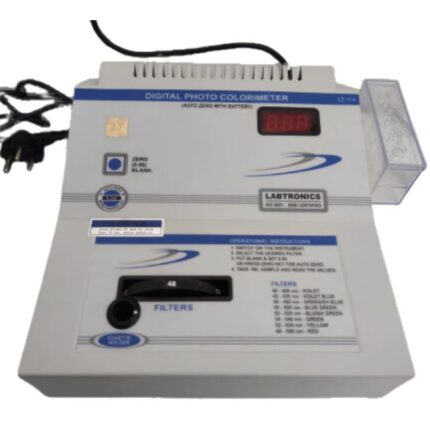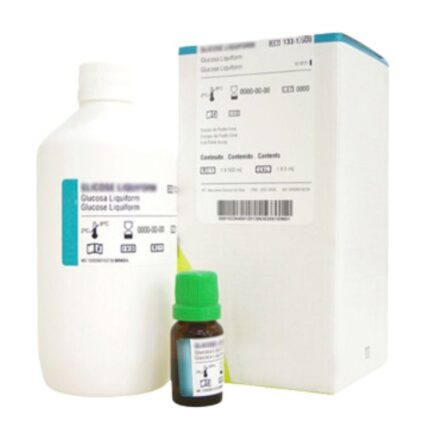Product Description
Cromatest Amylase Biochemistry Reagent 100 Test
PRINCIPLE
In this direct method1,2 a-amylase catalyzes the hydrolysis of 2- chloro-p-nitrophenyl-a-D-maltotrioside (CNP-G3) substrate at pH
6.0 forming 2-chloro-p-nitrophenol (CNP) and free glycosides.
The reaction is monitored kinetically at 405 nm by the rate of formation of the colored CNP produced, proportional to the activity of the a-amylase in the sample.
REFERENCE VALUES3
Serum And Plasma: < 86 U/L (1.43 mkat/L
Urine: < 470 U/L (7.83 mkat/L)
It is recommended that each laboratory establishes its own reference range
Best Quality Diagnostic Products Buy from Medistore
REAGENT COMPOSITION:
Monoreagent. MES buffer 50 mmol/L pH 6.0, calcium acetate 5 mmol/L, sodium chloride 300 mmol/L, sodium
thiocyanate 450 mmol/L, CNP-G3 2.25 mmol/L.
STORAGE AND STABILITY:
Store at 2-8 ºC.
The Monoreagent is stable until the expiry date stated on the label. Avoid contamination and recap the vials immediately after use (See Notes).
REAGENT PREPARATION
The Monoreagent is ready-to-use.
SAMPLES
Serum, heparinized plasma and urine.
Serum and plasma a-amylase is stable for 30 days at 2-8ºC. Random urine samples should be clear and precipitate free for testing. Check the pH. Urines with a pH < 5 may reduce the enzyme stability. Stable for 10 days at 2-8ºC.
Buy Hematology Analyzer Reagent at best price from Medistore
QUALITY CONTROL
To ensure adequate quality control (QC), each run should include a set of controls (normal and abnormal) with assayed values handled as unknowns.
CLINICAL SIGNIFICANCE
Amylase activity tests in serum and urine are mainly used in the diagnosis of diseases of the pancreas and in the investigation of pancreatic function.
Amylase is found chiefly in the saliva and in pancreatic tissue. Normally, small amounts of amylase are present in the blood, but with various forms of pancreatic disturbance large amounts of amylase are secreted into the blood by the pancreas.
The activity of the amylase in serum may fluctuate rapidily rising acutely during an attack and subsiding to normal levels shortly afterward.
Increased levels are found associated with acute pancreatitis, pancreatic duct obstrution, intra-abdominal diseases, mumps and bacterial parotitis.
A significant amount of the serum amylase is excreted in the urine, and as a result elevation of serum activity is reflected in the rise of urinary amylase activity. Urine amylase appears to be more frecuently elevated, reaches higher levels, and persists for longer periods.4
NOTES
- Do not pipette by mouth, use gloves and avoid contact with skin. They both contain amylase.
ANALYTICAL PERFORMANCE
- Linearity: Up to 1000 U/L
- Precision
U/L Within-run Between-run Mean 50.3 134.1 306 50.3 129 320 SD 0.78 2.31 2.79 1.16 2.6 3.1 CV% 1.55 1.72 0.65 2.32 2.01 0.96 N 10 10 10 10 10 10
Replicates: 10 for each level. Replicates: 10 for each level Instrument: CECIL CE 2001 for 8 days.
- Sensitivity. Using this reagent and method an DA/min of 001 read at 405 nm is equivalent to 5 U/L of amylase activity.
- Correlation. This assay (y) was compared with a similar commercial method (x). The results were:
N = 30 r = 0.998 y = 0.9241x + 5.237
INTERFERENCES
1.Common anticoagulants, as citrate, oxalate or EDTA inhibit the enzyme
2.Bilirubin (> 20 mg/dL) and lipids (triglycerides > 10 g/L) do not interfere.
3. Other drugs and substances may interfere3.
MATERIALS REQUIRED
- Photometer or spectrophotometer with a thermostatted cell compartment set at 37ºC, capable of reading at 405 nm.Stopwatch, strip-chart recorder or printer. Cuvettes with 1-cm pathlength.Pipettes to measure reagent and samples.
PROCEDURE
1.Preincubate working reagent, samples and controls to reaction temperature.
2.Set the photometer to 0 absorbance with distilled water
3.Pipette into a cuvette:
| Reaction temperature | 37ºC | |
| Monoreagent Serum/plasma Urine | 1.0 mL 20 mL
– |
1.0 mL
– 10 mL |
Mix gently by inversion. Insert cuvette into the cell holder and start stopwatch.
Incubate for 1 minute and record initial absorbance reading. Repeat the absorbance readings exactly after 1, 2 and 3 minutes.
Calculate the difference between absorbances.
Calculate the mean of the results to obtain the average change
in absorbance per minute (DA/min).
Calculations: Samples with DA/min exceeding 0.500 at 405 nm should be diluted 1:10 with saline and assayed again. Multiply the results by 10.
If results are to be expressed as SI units apply: U/L x 0.01667 = mkat/L
REFERENCES
- Winn-Deen, E.S., David, H., Sigler, G, and Chavez, R. Clin. Chem. 34 : 2005 (1988).International Federation of Clinical Chemistry (IFCC). Clin. Chem. Lab. Med. 36 : 185 (1998).Young, D.S. Effects of Drugs on Clinical Laboratory Tests. 4 thEdition. AACC Press (1995).Tiete. Textbook of Clinical Chemist, 2 Edition. Bruits CA, Ashwood ER. WB Saunders Co., 1994.












Reviews
There are no reviews yet.